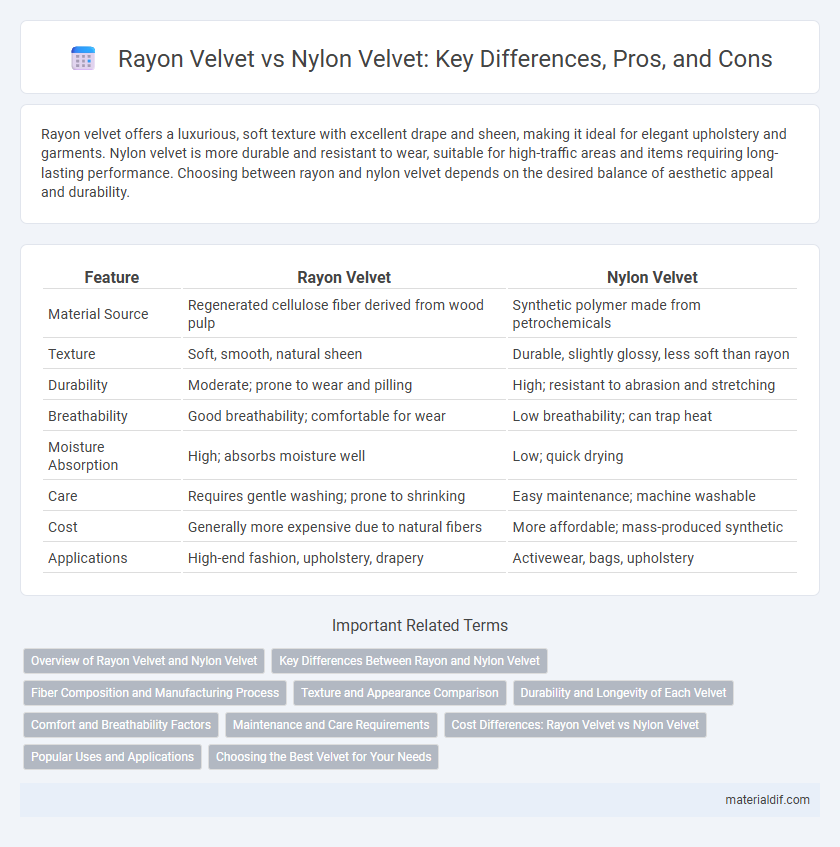Rayon velvet offers a luxurious, soft texture with excellent drape and sheen, making it ideal for elegant upholstery and garments. Nylon velvet is more durable and resistant to wear, suitable for high-traffic areas and items requiring long-lasting performance. Choosing between rayon and nylon velvet depends on the desired balance of aesthetic appeal and durability.
Table of Comparison
| Feature | Rayon Velvet | Nylon Velvet |
|---|---|---|
| Material Source | Regenerated cellulose fiber derived from wood pulp | Synthetic polymer made from petrochemicals |
| Texture | Soft, smooth, natural sheen | Durable, slightly glossy, less soft than rayon |
| Durability | Moderate; prone to wear and pilling | High; resistant to abrasion and stretching |
| Breathability | Good breathability; comfortable for wear | Low breathability; can trap heat |
| Moisture Absorption | High; absorbs moisture well | Low; quick drying |
| Care | Requires gentle washing; prone to shrinking | Easy maintenance; machine washable |
| Cost | Generally more expensive due to natural fibers | More affordable; mass-produced synthetic |
| Applications | High-end fashion, upholstery, drapery | Activewear, bags, upholstery |
Overview of Rayon Velvet and Nylon Velvet
Rayon velvet is a soft, breathable fabric made from regenerated cellulose fibers, known for its luxurious sheen and smooth texture, making it ideal for upholstery and apparel. Nylon velvet offers increased durability and elasticity due to its synthetic polymer composition, providing resistance to abrasion and stretching. Both fabrics feature a plush pile, but rayon velvet emphasizes comfort and natural appearance, while nylon velvet prioritizes strength and longevity.
Key Differences Between Rayon and Nylon Velvet
Rayon velvet offers a soft, breathable texture with natural drape and moisture absorption, ideal for luxurious apparel and upholstery. Nylon velvet, on the other hand, provides superior durability, increased elasticity, and resistance to abrasion, making it suitable for high-traffic areas and outdoor use. Key differences include rayon's natural fiber origin versus nylon's synthetic composition, affecting comfort, resilience, and maintenance.
Fiber Composition and Manufacturing Process
Rayon velvet is made from regenerated cellulose fibers derived from wood pulp, resulting in a soft, breathable fabric with excellent drape, while nylon velvet is crafted from synthetic polyamide fibers known for high durability and elasticity. The manufacturing process for rayon velvet involves chemically regenerating cellulose and then weaving the fibers into a dense pile, whereas nylon velvet is produced through polymer extrusion followed by weaving and pile finishing. Differences in fiber composition lead to rayon velvet having a more natural feel, whereas nylon velvet offers greater strength and resistance to abrasion.
Texture and Appearance Comparison
Rayon velvet offers a luxurious, soft texture with a subtle sheen that enhances its rich appearance, making it ideal for elegant upholstery and garments. Nylon velvet, by contrast, features a smoother, more durable surface with a slightly shinier finish, often used in high-traffic applications due to its resilience. The choice between rayon and nylon velvet depends on the desired balance between softness and durability, as well as the specific aesthetic requirements of the project.
Durability and Longevity of Each Velvet
Rayon velvet offers a luxurious texture but tends to be less durable and more prone to wear over time compared to nylon velvet. Nylon velvet features enhanced strength and resilience, making it more resistant to abrasion and ideal for high-traffic areas. The longevity of nylon velvet surpasses rayon velvet, providing a more enduring fabric choice for upholstery and fashion applications.
Comfort and Breathability Factors
Rayon velvet offers superior breathability and softness due to its natural cellulose fibers, making it more comfortable for prolonged wear and warmer climates. Nylon velvet, composed of synthetic fibers, tends to trap heat and moisture, reducing comfort and airflow during extended use. Choosing rayon velvet enhances ventilation and moisture absorption, key factors for maintaining comfort in velvet fabrics.
Maintenance and Care Requirements
Rayon velvet demands gentle hand washing or dry cleaning to maintain its softness and avoid fiber damage, as it is prone to shrinking and loss of texture when exposed to heat or harsh detergents. Nylon velvet offers greater durability and can often be machine washed on a delicate cycle, making maintenance simpler and more resistant to wear and tear. Proper care, including prompt stain treatment and avoiding excessive friction, extends the lifespan of both fabrics but is especially critical for rayon velvet to preserve its luxurious feel.
Cost Differences: Rayon Velvet vs Nylon Velvet
Rayon velvet typically costs less than nylon velvet due to its semi-synthetic, cellulose-based fibers that are easier and cheaper to produce. Nylon velvet, made from fully synthetic polymers, tends to have a higher price point reflecting its durability and resistance to abrasion. Budget-conscious buyers often prefer rayon velvet for its affordability, while those seeking enhanced longevity may invest in the costlier nylon velvet.
Popular Uses and Applications
Rayon velvet is prized for its soft texture and luxurious appearance, making it popular for elegant upholstery, drapery, and high-end fashion garments. Nylon velvet is favored for its durability and resistance to wear, commonly used in activewear, outerwear, and commercial upholstery. Both fabrics serve distinct market needs, with rayon velvet enhancing aesthetics and nylon velvet providing functional resilience.
Choosing the Best Velvet for Your Needs
Rayon velvet offers a soft, breathable texture with excellent draping qualities, making it ideal for garments and upholstery that require comfort and fluidity. Nylon velvet provides superior durability, resistance to abrasion, and maintains its vibrant color over time, suited for high-traffic areas and long-lasting applications. Selecting between rayon and nylon velvet depends on whether the priority is luxurious feel and breathability or enhanced strength and longevity.
Rayon Velvet vs Nylon Velvet Infographic

 materialdif.com
materialdif.com